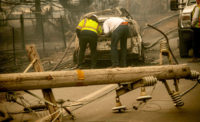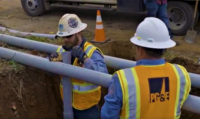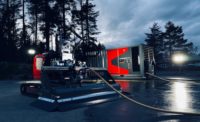If a tree falls in the forest and no one is around to hear it, it can still land on a power line and start a wildfire.
A Silicon Valley startup called Dispatchr Inc. is partnering with Hitachi Consulting Corp. to couple big data with machine learning to create what the developers call a Digital Immune System (DIS) for power grids. It is designed to detect patterns of tree failure and other potential fire-starters—given certain maintenance status, terrain and weather conditions—and warn electrical utilities about impending danger at specific locations, well in advance.
“Climate change and aging infrastructure are increasing the frequency of wildfires and other disasters,” says Ralph Garvin Jr., CEO of Dispatchr Inc. Erupting fires can quickly cascade into widespread disasters if they compromise the power grid. “Once you lose heat, light and power, civilization collapses,” Garvin says. “This is the reason that the Digital Immune System exists. We want to protect the services on which civilization rests.”
Hitachi’s machine learning engine, called H, is a general-purpose deep-learning system that uses data aggregated by Dispatchr’s DIS to study the conditions that produce both wildfires and outages, and then predict when and where such conditions may arise, says Hicham Abdessamad, president and CEO of Hitachi Consulting.
To feed the analysis, DIS aggregates inputs such as vegetation data, satellite and LiDAR imagery, utility asset data in GIS format, and 72-hour predictive weather forecasts. One of the most important additional inputs is fuel-load data, which comes from government website CAL FIRE and other sources across the country, says Garvin. “The possibility of tree failure near power lines in areas where fuel load is high and [risk of ignition is high] constitute areas of high wildfire risk,” Garvin says.
The system predicts the locations of potential fires sparked by the confluence of risk factors and then warns electric utilities so the risk can be mitigated.
Garvin says DIS works by finding patterns in big data. “We know these patterns exist, but they have complexity beyond human inspection,” he explains. “But humans have the ability to create machines to find that complexity. And the machines get more accurate in their predictions as the DIS exposes them to more patterns and data.”
The system also continually flags assets that require maintenance or trees that pose risks to lines and facilities, and notifies the responsible parties of the need to address them. “The digital immune system will continuously train the AI to detect tree, line or equipment failures before they occur,” says Hitachi’s Abdessamad.
Garvin says several utilities—which declined to be identified or comment for this report—have participated in Dispatchr/Hitachi DIS tests during the last three years. “In 2016 it monitored more than 70,000 sq miles and prevented a dozen fires and a half dozen outages—one of which could have blacked out the whole West Coast,” claims Garvin.
Dispatchr not only helps manage the threats, it also helps to manage logistics for utilities responding to them. Once a situation is flagged as a threat, the system automatically alerts workers in the field and guides them to the GPS location of the problem via mobile devices so the issue can be dealt with. The moment the threat is mitigated, workers document the change with a photo or video and feed that, along with other relevant data, back into the system. The information updates the neural network’s capacity to predict the next threat.
Dispatchr has been made available to utilities on a limited basis, priced according to “the size and scale of the system purchased,” says Garvin, who adds that the service is typically being treated as a capital expense.






Post a comment to this article
Report Abusive Comment